2000 FORD F SERIES MOTORHOME AND COMMERCIAL CHASSIS jump start
[x] Cancel search: jump startPage 52 of 104
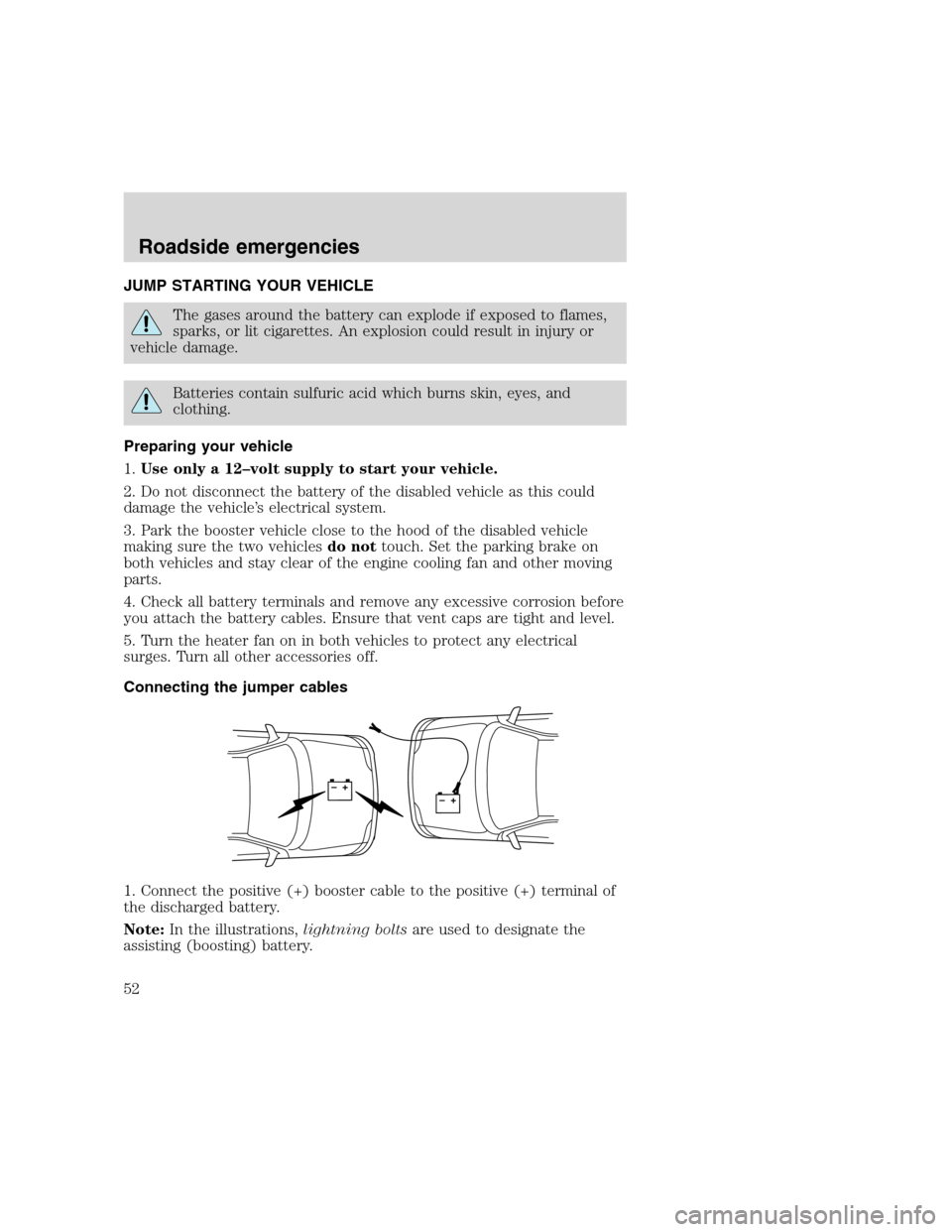
JUMP STARTING YOUR VEHICLE
The gases around the battery can explode if exposed to flames,
sparks, or lit cigarettes. An explosion could result in injury or
vehicle damage.
Batteries contain sulfuric acid which burns skin, eyes, and
clothing.
Preparing your vehicle
1.Use only a 12–volt supply to start your vehicle.
2. Do not disconnect the battery of the disabled vehicle as this could
damage the vehicle’s electrical system.
3. Park the booster vehicle close to the hood of the disabled vehicle
making sure the two vehiclesdo nottouch. Set the parking brake on
both vehicles and stay clear of the engine cooling fan and other moving
parts.
4. Check all battery terminals and remove any excessive corrosion before
you attach the battery cables. Ensure that vent caps are tight and level.
5. Turn the heater fan on in both vehicles to protect any electrical
surges. Turn all other accessories off.
Connecting the jumper cables
1. Connect the positive (+) booster cable to the positive (+) terminal of
the discharged battery.
Note:In the illustrations,lightning boltsare used to designate the
assisting (boosting) battery.
+–+–
Roadside emergencies
52
Page 54 of 104
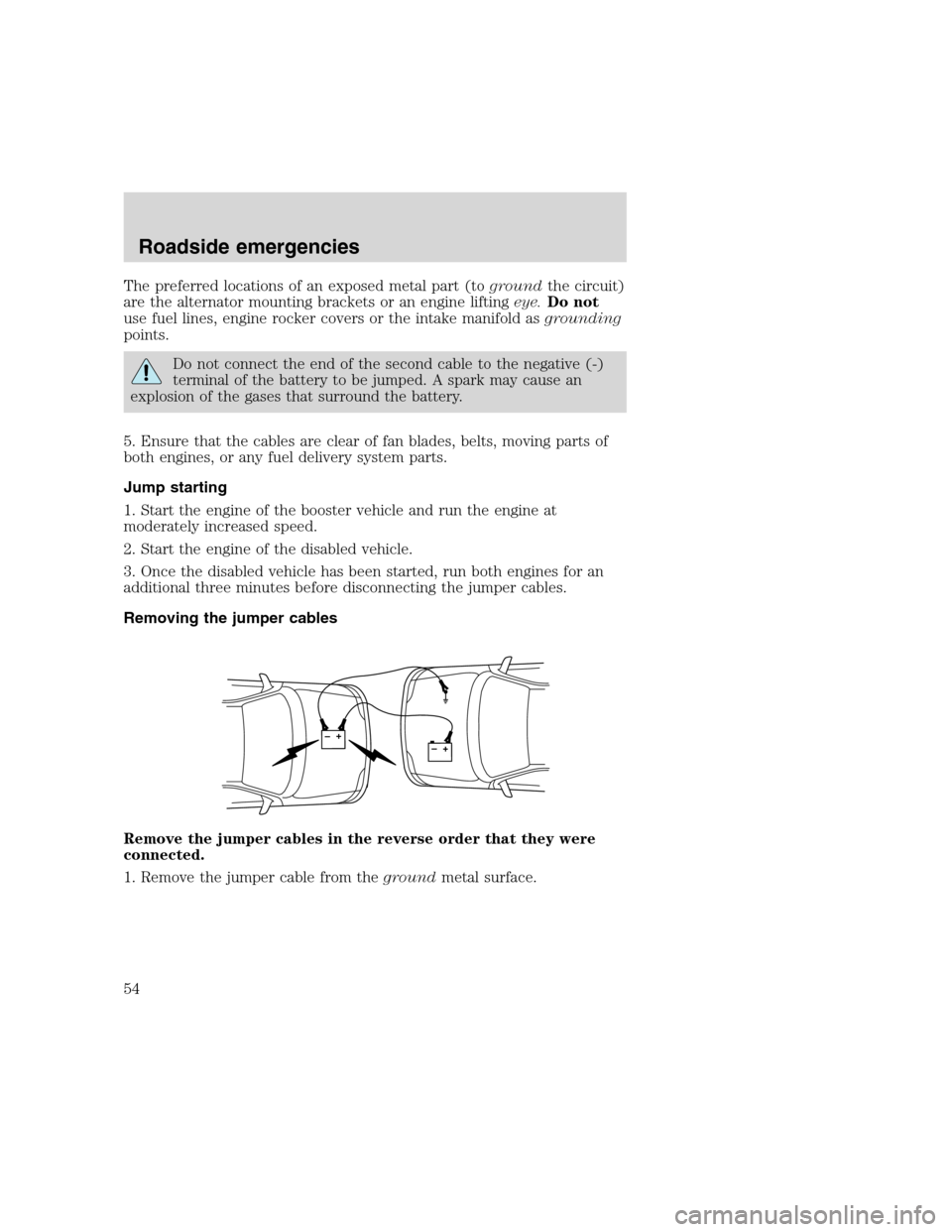
The preferred locations of an exposed metal part (togroundthe circuit)
are the alternator mounting brackets or an engine liftingeye.Do not
use fuel lines, engine rocker covers or the intake manifold asgrounding
points.
Do not connect the end of the second cable to the negative (-)
terminal of the battery to be jumped. A spark may cause an
explosion of the gases that surround the battery.
5. Ensure that the cables are clear of fan blades, belts, moving parts of
both engines, or any fuel delivery system parts.
Jump starting
1. Start the engine of the booster vehicle and run the engine at
moderately increased speed.
2. Start the engine of the disabled vehicle.
3. Once the disabled vehicle has been started, run both engines for an
additional three minutes before disconnecting the jumper cables.
Removing the jumper cables
Remove the jumper cables in the reverse order that they were
connected.
1. Remove the jumper cable from thegroundmetal surface.
+–+–
Roadside emergencies
54
Page 56 of 104
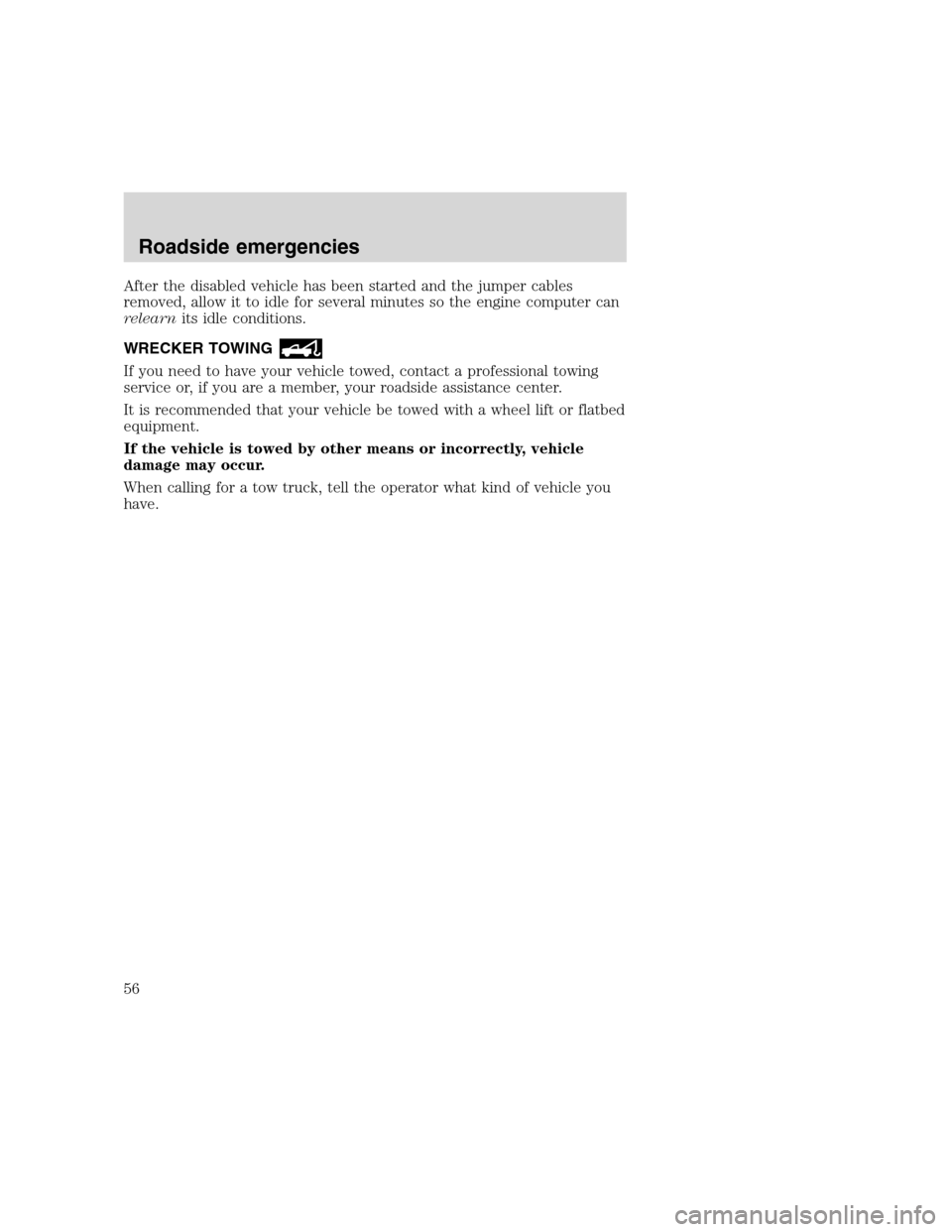
After the disabled vehicle has been started and the jumper cables
removed, allow it to idle for several minutes so the engine computer can
relearnits idle conditions.
WRECKER TOWING
If you need to have your vehicle towed, contact a professional towing
service or, if you are a member, your roadside assistance center.
It is recommended that your vehicle be towed with a wheel lift or flatbed
equipment.
If the vehicle is towed by other means or incorrectly, vehicle
damage may occur.
When calling for a tow truck, tell the operator what kind of vehicle you
have.
Roadside emergencies
56
Page 98 of 104
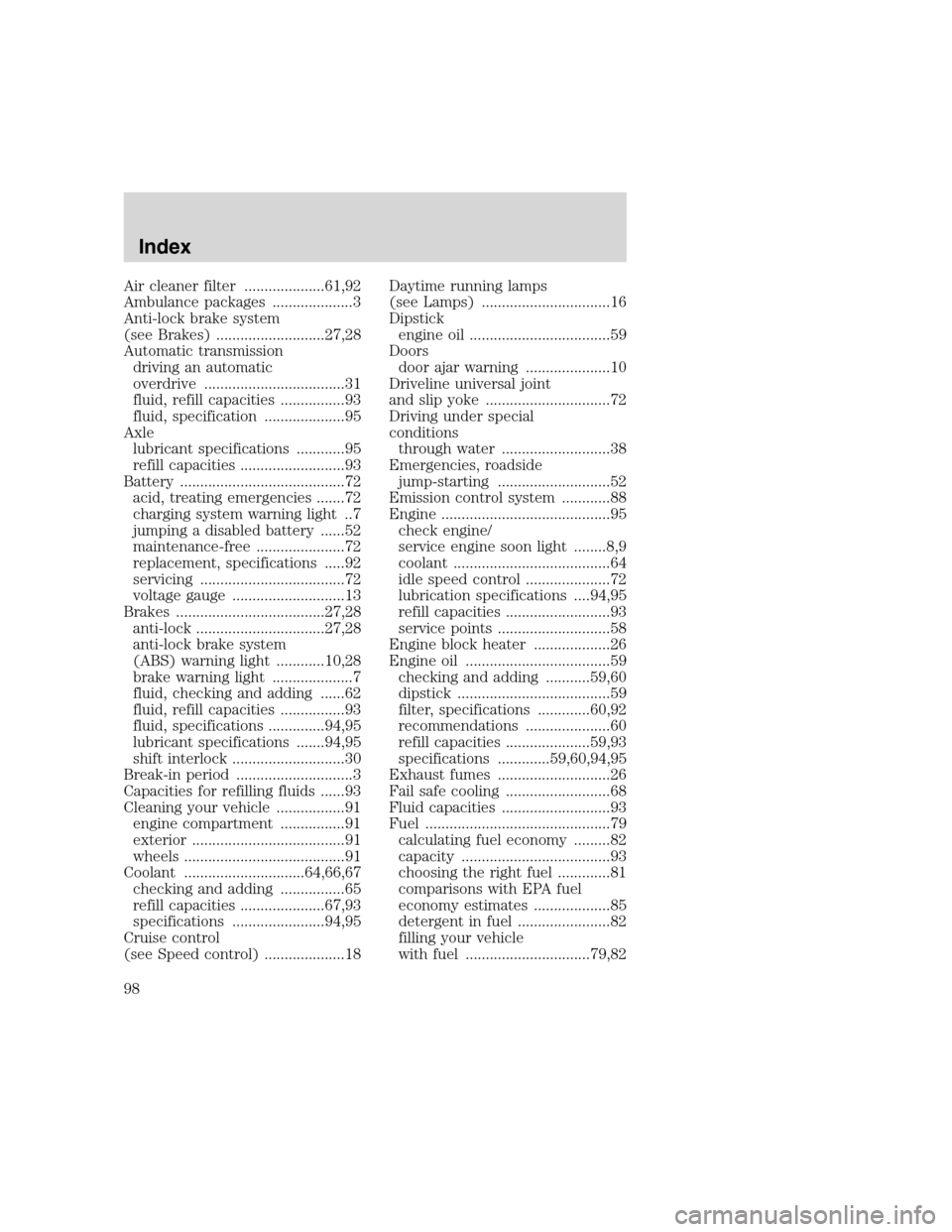
Air cleaner filter ....................61,92
Ambulance packages ....................3
Anti-lock brake system
(see Brakes) ...........................27,28
Automatic transmission
driving an automatic
overdrive ...................................31
fluid, refill capacities ................93
fluid, specification ....................95
Axle
lubricant specifications ............95
refill capacities ..........................93
Battery .........................................72
acid, treating emergencies .......72
charging system warning light ..7
jumping a disabled battery ......52
maintenance-free ......................72
replacement, specifications .....92
servicing ....................................72
voltage gauge ............................13
Brakes .....................................27,28
anti-lock ................................27,28
anti-lock brake system
(ABS) warning light ............10,28
brake warning light ....................7
fluid, checking and adding ......62
fluid, refill capacities ................93
fluid, specifications ..............94,95
lubricant specifications .......94,95
shift interlock ............................30
Break-in period .............................3
Capacities for refilling fluids ......93
Cleaning your vehicle .................91
engine compartment ................91
exterior ......................................91
wheels ........................................91
Coolant ..............................64,66,67
checking and adding ................65
refill capacities .....................67,93
specifications .......................94,95
Cruise control
(see Speed control) ....................18Daytime running lamps
(see Lamps) ................................16
Dipstick
engine oil ...................................59
Doors
door ajar warning .....................10
Driveline universal joint
and slip yoke ...............................72
Driving under special
conditions
through water ...........................38
Emergencies, roadside
jump-starting ............................52
Emission control system ............88
Engine ..........................................95
check engine/
service engine soon light ........8,9
coolant .......................................64
idle speed control .....................72
lubrication specifications ....94,95
refill capacities ..........................93
service points ............................58
Engine block heater ...................26
Engine oil ....................................59
checking and adding ...........59,60
dipstick ......................................59
filter, specifications .............60,92
recommendations .....................60
refill capacities .....................59,93
specifications .............59,60,94,95
Exhaust fumes ............................26
Fail safe cooling ..........................68
Fluid capacities ...........................93
Fuel ..............................................79
calculating fuel economy .........82
capacity .....................................93
choosing the right fuel .............81
comparisons with EPA fuel
economy estimates ...................85
detergent in fuel .......................82
filling your vehicle
with fuel ...............................79,82
Index
98
Page 99 of 104
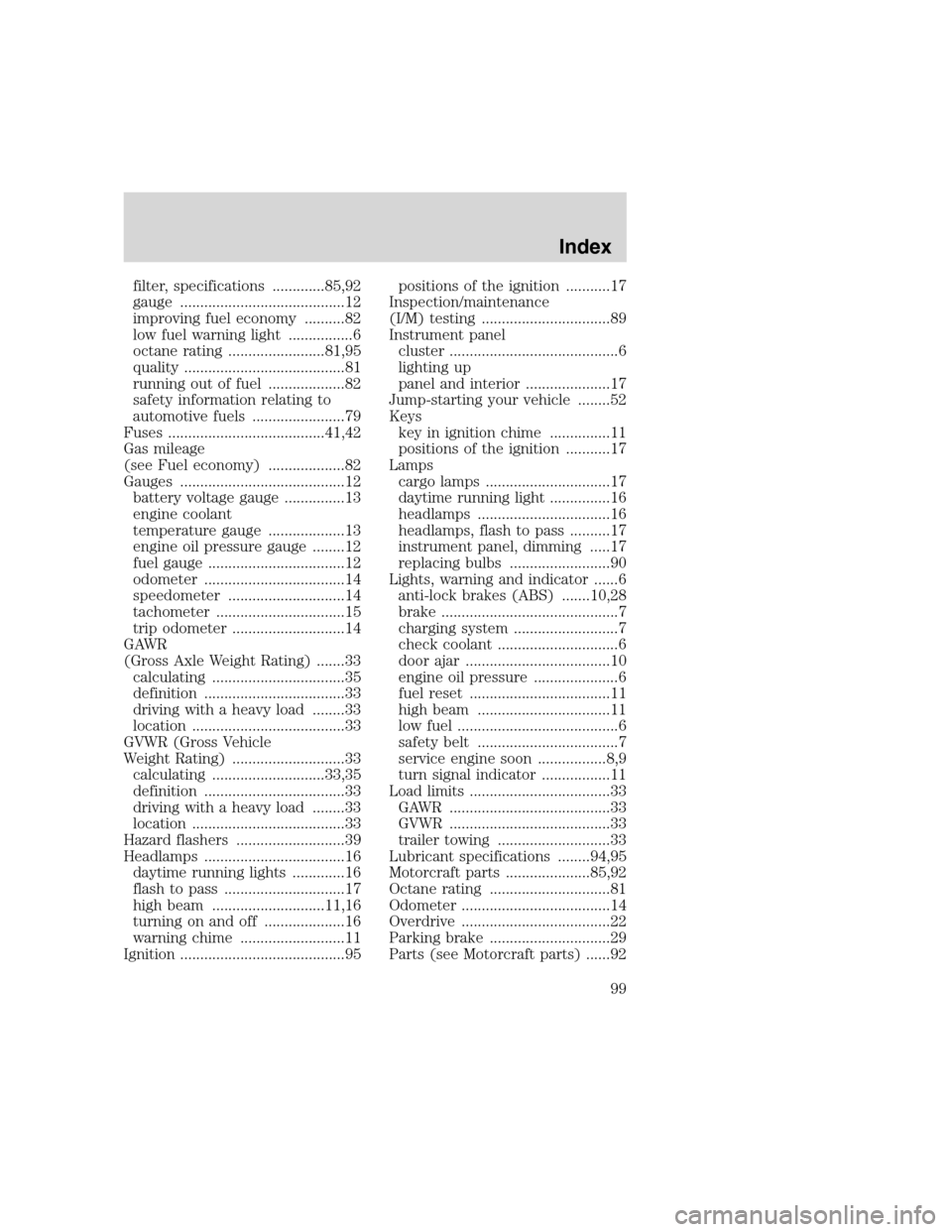
filter, specifications .............85,92
gauge .........................................12
improving fuel economy ..........82
low fuel warning light ................6
octane rating ........................81,95
quality ........................................81
running out of fuel ...................82
safety information relating to
automotive fuels .......................79
Fuses .......................................41,42
Gas mileage
(see Fuel economy) ...................82
Gauges .........................................12
battery voltage gauge ...............13
engine coolant
temperature gauge ...................13
engine oil pressure gauge ........12
fuel gauge ..................................12
odometer ...................................14
speedometer .............................14
tachometer ................................15
trip odometer ............................14
GAWR
(Gross Axle Weight Rating) .......33
calculating .................................35
definition ...................................33
driving with a heavy load ........33
location ......................................33
GVWR (Gross Vehicle
Weight Rating) ............................33
calculating ............................33,35
definition ...................................33
driving with a heavy load ........33
location ......................................33
Hazard flashers ...........................39
Headlamps ...................................16
daytime running lights .............16
flash to pass ..............................17
high beam ............................11,16
turning on and off ....................16
warning chime ..........................11
Ignition .........................................95positions of the ignition ...........17
Inspection/maintenance
(I/M) testing ................................89
Instrument panel
cluster ..........................................6
lighting up
panel and interior .....................17
Jump-starting your vehicle ........52
Keys
key in ignition chime ...............11
positions of the ignition ...........17
Lamps
cargo lamps ...............................17
daytime running light ...............16
headlamps .................................16
headlamps, flash to pass ..........17
instrument panel, dimming .....17
replacing bulbs .........................90
Lights, warning and indicator ......6
anti-lock brakes (ABS) .......10,28
brake ............................................7
charging system ..........................7
check coolant ..............................6
door ajar ....................................10
engine oil pressure .....................6
fuel reset ...................................11
high beam .................................11
low fuel ........................................6
safety belt ...................................7
service engine soon .................8,9
turn signal indicator .................11
Load limits ...................................33
GAWR ........................................33
GVWR ........................................33
trailer towing ............................33
Lubricant specifications ........94,95
Motorcraft parts .....................85,92
Octane rating ..............................81
Odometer .....................................14
Overdrive .....................................22
Parking brake ..............................29
Parts (see Motorcraft parts) ......92
Index
99
Page 100 of 104
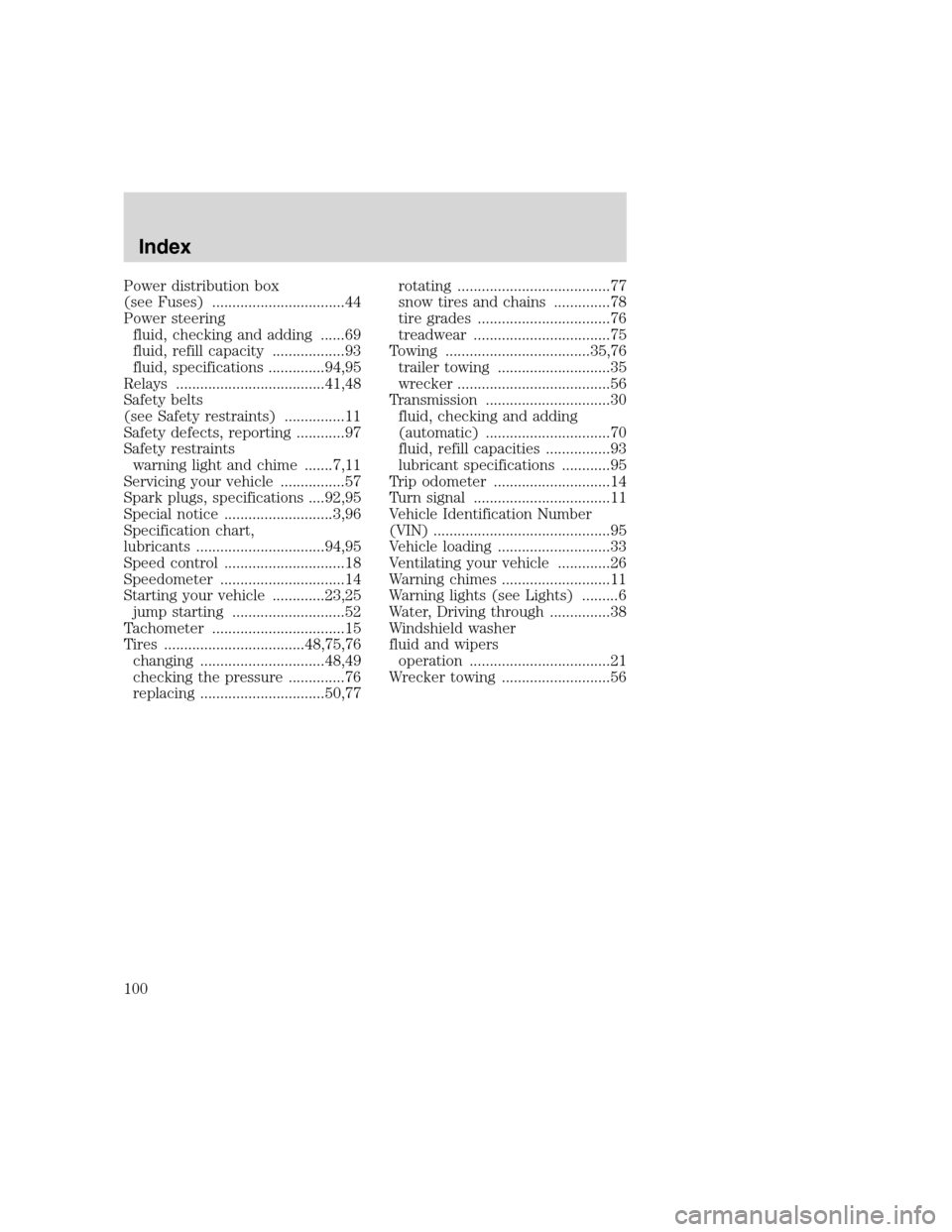
Power distribution box
(see Fuses) .................................44
Power steering
fluid, checking and adding ......69
fluid, refill capacity ..................93
fluid, specifications ..............94,95
Relays .....................................41,48
Safety belts
(see Safety restraints) ...............11
Safety defects, reporting ............97
Safety restraints
warning light and chime .......7,11
Servicing your vehicle ................57
Spark plugs, specifications ....92,95
Special notice ...........................3,96
Specification chart,
lubricants ................................94,95
Speed control ..............................18
Speedometer ...............................14
Starting your vehicle .............23,25
jump starting ............................52
Tachometer .................................15
Tires ...................................48,75,76
changing ...............................48,49
checking the pressure ..............76
replacing ...............................50,77rotating ......................................77
snow tires and chains ..............78
tire grades .................................76
treadwear ..................................75
Towing ....................................35,76
trailer towing ............................35
wrecker ......................................56
Transmission ...............................30
fluid, checking and adding
(automatic) ...............................70
fluid, refill capacities ................93
lubricant specifications ............95
Trip odometer .............................14
Turn signal ..................................11
Vehicle Identification Number
(VIN) ............................................95
Vehicle loading ............................33
Ventilating your vehicle .............26
Warning chimes ...........................11
Warning lights (see Lights) .........6
Water, Driving through ...............38
Windshield washer
fluid and wipers
operation ...................................21
Wrecker towing ...........................56
Index
100